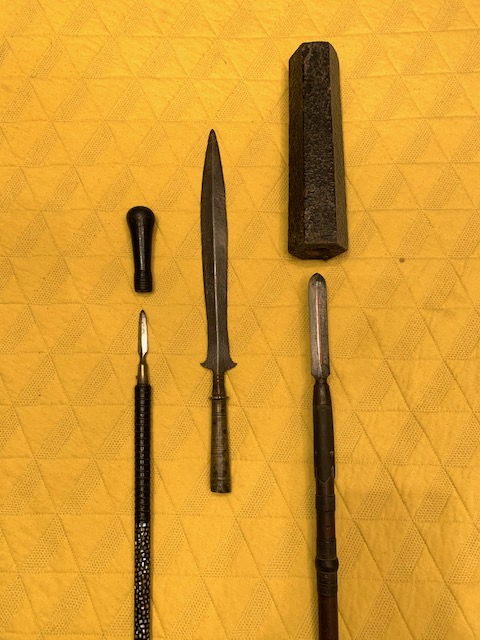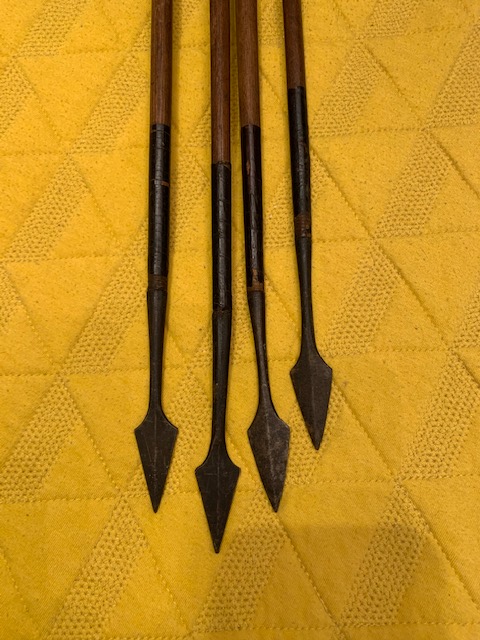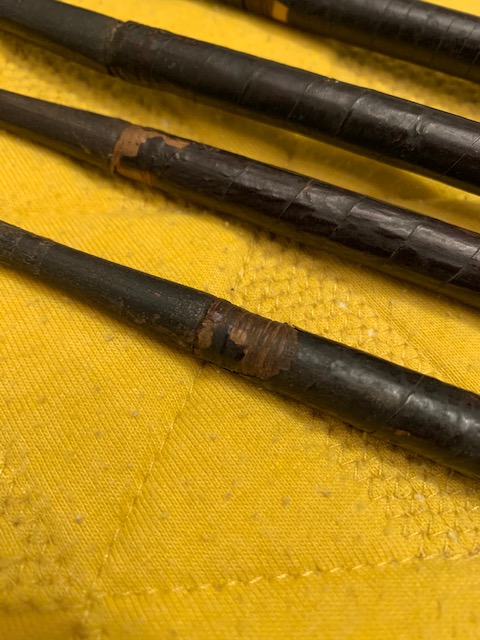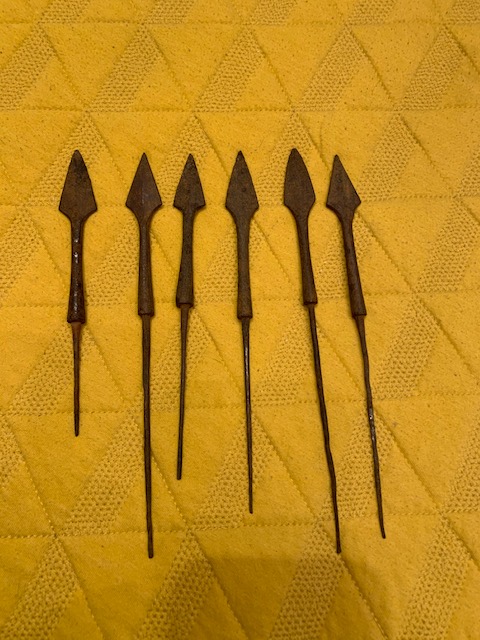I was thinking the other day seeing a bunch of European medieval bodkin arrowheads a friend had and comparing to the few medieval crossbow and longbow arrowheads I have and have seen in books and museums, there seems to be a mix of socket and tang heads. Is this right or a reason for it ?
There seems to be a logical advantage in sockets for spears because of strength. I wondered whether the same was relevant to arrowheads as they are one-shot weapons in that even if recovered they only have to stay straight on their shaft to deliver the penetration Or is there a difference in performance between socket and tang ?
Struck me that socket should be easier to fit as you don't have to make a hole in the shaft, and also to refit to new arrows in the field if recovered. Also struck me they may be harder to make ? And they would presumably be heavier (I was perhaps not surprised but struck by the difference, the first time I had a go at shooting a longbow with a wooden arrow with an iron broadhead, by the difference in feel and trajectory compared to modern target arrows ).
Interested as like archery and related historical topics but seemed there would be a clearer divide between socket and tang. Unless of course there is and what I have seen is not representative.
D
Hi Daniel,
You've somehow landed on another one of my areas of interest ;).
I'm no expert, but I do have some thoughts and things to share on your comments. More points to add rather than answers though.
Yes I think you are right here but there are also many examples of tanged spears (see below image, right to left: Japanese kago yari, Malaysian spear, long yari). All three of these spear heads are tanged, however, you can see in each case that the tanged spear is combined with a ferrule or some type of external shaft reinforcement. Note: the Malaysian spear looks socketed, but this is a brass ferrule which would have been on the outside of the shaft, and inside is a tang that would have been inserted into the shaft.
For the arrows that I am familiar with it is much the same as the spear. The images below show four Qing Dynasty war arrows (44in long, 1/2in diameter shaft, over 100g each). The Qing Dynasty was known for it's excellent archers. They shot these very heavy and robust arrows from extremely powerful bows. These four examples each show signs of being shot and are most likely trophy bring backs picked from the field during the first opium war (1842 ish). They are still in excellent condition even today which is likely because of their construction. Just behind the head, the shaft is wrapped with peach bark but under that is a wrap of sinew (in the last picture you can see the sinew peaking through in an area where the bark has pealed off). Sinew is exceptionally strong and is serving the same purpose as the ferrules in the spears mentioned above. My guess is that without this wrap of sinew, none of these arrows would still have their point. I am not aware of any historical tanged arrow type that does not also have some sort of circumferential strengthening of the shaft near the point. To make a long story short, all arrows that I am aware of are built to take a large amount of impact without damage, and I believe there is a functional reason for this. In order to effectively deliver the energy stored in the moving arrow, the arrow must stay in line upon impact. If there is any breaking or buckling of the arrow it would dissipate a large amount of the energy and the penetration would suffer greatly.
I think you hit the nail on the head here. I have forged both types of points, and the tanged point is definitely easier to make, but I think it would be far more difficult to mount. For socketed arrows you simply have to sharpen the end of the shaft and glue it into the socket, but for the tang you need to drill or split the shaft, mount the point, and then reinforce and glue the shaft. Perhaps it is just a case of trade-offs between the two during manufacture. I also think your point about refit of socket arrows could be valid especially if on campaign.
Regarding the weight I don't think that socketed points are by default heavier. The points on the war arrows below are very heavy and there is easily enough material there to make a socket. On the other end of the spectrum I have seen some very small socketed points. My guess is that the weight of either type could be tailored to the type and size of arrow without problem.
Just my 2c
As a side note, if you are interested in archery, you should definitely check out Peter Dekker's Manchu archery site. Very interesting stuff IMO. http://www.manchuarchery.org/articles-manchu-archery
 Attachment: 132.14 KB
Attachment: 132.14 KB

Tanged spears
 Attachment: 131.13 KB
Attachment: 131.13 KB

Tanged war arrows
 Attachment: 117.18 KB
Attachment: 117.18 KB

Sinew shaft reinforcement
You've somehow landed on another one of my areas of interest ;).
I'm no expert, but I do have some thoughts and things to share on your comments. More points to add rather than answers though.
| Daniel Parry wrote: |
| There seems to be a logical advantage in sockets for spears because of strength.
|
Yes I think you are right here but there are also many examples of tanged spears (see below image, right to left: Japanese kago yari, Malaysian spear, long yari). All three of these spear heads are tanged, however, you can see in each case that the tanged spear is combined with a ferrule or some type of external shaft reinforcement. Note: the Malaysian spear looks socketed, but this is a brass ferrule which would have been on the outside of the shaft, and inside is a tang that would have been inserted into the shaft.
| Daniel Parry wrote: |
|
I wondered whether the same was relevant to arrowheads as they are one-shot weapons in that even if recovered they only have to stay straight on their shaft to deliver the penetration Or is there a difference in performance between socket and tang ? |
For the arrows that I am familiar with it is much the same as the spear. The images below show four Qing Dynasty war arrows (44in long, 1/2in diameter shaft, over 100g each). The Qing Dynasty was known for it's excellent archers. They shot these very heavy and robust arrows from extremely powerful bows. These four examples each show signs of being shot and are most likely trophy bring backs picked from the field during the first opium war (1842 ish). They are still in excellent condition even today which is likely because of their construction. Just behind the head, the shaft is wrapped with peach bark but under that is a wrap of sinew (in the last picture you can see the sinew peaking through in an area where the bark has pealed off). Sinew is exceptionally strong and is serving the same purpose as the ferrules in the spears mentioned above. My guess is that without this wrap of sinew, none of these arrows would still have their point. I am not aware of any historical tanged arrow type that does not also have some sort of circumferential strengthening of the shaft near the point. To make a long story short, all arrows that I am aware of are built to take a large amount of impact without damage, and I believe there is a functional reason for this. In order to effectively deliver the energy stored in the moving arrow, the arrow must stay in line upon impact. If there is any breaking or buckling of the arrow it would dissipate a large amount of the energy and the penetration would suffer greatly.
| Daniel Parry wrote: |
|
Struck me that socket should be easier to fit as you don't have to make a hole in the shaft, and also to refit to new arrows in the field if recovered. Also struck me they may be harder to make ? And they would presumably be heavier (I was perhaps not surprised but struck by the difference, the first time I had a go at shooting a longbow with a wooden arrow with an iron broadhead, by the difference in feel and trajectory compared to modern target arrows ). |
I think you hit the nail on the head here. I have forged both types of points, and the tanged point is definitely easier to make, but I think it would be far more difficult to mount. For socketed arrows you simply have to sharpen the end of the shaft and glue it into the socket, but for the tang you need to drill or split the shaft, mount the point, and then reinforce and glue the shaft. Perhaps it is just a case of trade-offs between the two during manufacture. I also think your point about refit of socket arrows could be valid especially if on campaign.
Regarding the weight I don't think that socketed points are by default heavier. The points on the war arrows below are very heavy and there is easily enough material there to make a socket. On the other end of the spectrum I have seen some very small socketed points. My guess is that the weight of either type could be tailored to the type and size of arrow without problem.
Just my 2c
As a side note, if you are interested in archery, you should definitely check out Peter Dekker's Manchu archery site. Very interesting stuff IMO. http://www.manchuarchery.org/articles-manchu-archery

Tanged spears

Tanged war arrows

Sinew shaft reinforcement
Just noticed when I posted that the Qing arrows almost look socketed. To clarify, here is what the points look like when they are not mounted.
 Attachment: 117.83 KB
Attachment: 117.83 KB


Don't forget in many parts of the world you could make arrow shafts out of heavy grass stalks like bamboo or reeds, so a tanged arrowhead is not necessarily difficult to mount.
IIRC, though, some Scythians actually used reed shafts and socketed heads. They added wooden inserts between them, sort of like modular tangs.
IIRC, though, some Scythians actually used reed shafts and socketed heads. They added wooden inserts between them, sort of like modular tangs.
I might be mistaken but I often get the impression period war arrows weren't necessarily meant to rapidly cause death by bleeding out but rather aimed to wound and impede enemies by sticking in them and being hard to remove.
A socketed arrow and an arrow with a tang actually seem to require different medical tools to extract them successfully. Paul of Aegina briefly mentions this.
 Attachment: 101.34 KB
Attachment: 101.34 KB
[ Download ]
 Attachment: 199.86 KB
Attachment: 199.86 KB
[ Download ]
A socketed arrow and an arrow with a tang actually seem to require different medical tools to extract them successfully. Paul of Aegina briefly mentions this.
[ Download ]
[ Download ]
| Pieter B. wrote: |
| I might be mistaken but I often get the impression period war arrows weren't necessarily meant to rapidly cause death by bleeding out but rather aimed to wound and impede enemies by sticking in them and being hard to remove.
A socketed arrow and an arrow with a tang actually seem to require different medical tools to extract them successfully. Paul of Aegina briefly mentions this. |
Good point ;) . I have read that the points on English arrows were only lightly glued so they may fall off on penetration (not sure where this came from though or how much evidence there is to support it). The Manchu arrows above were definitely made to keep the head intact. They have a wrap of sinew on the tang itself which I believe is placed on before the tang is inserted in the drilled and split shaft so that when the split is closed and tightly wrapped with sinew on the outside there is no way to remove the tang without destroying the whole end of the shaft.
A feature of the Manchu war arrows related to impeding rather than just killing is that the points were intentionally blunted to impart more of a punch on impact rather than just passing through.
Page 1 of 1
You cannot post new topics in this forumYou cannot reply to topics in this forum
You cannot edit your posts in this forum
You cannot delete your posts in this forum
You cannot vote in polls in this forum
You cannot attach files in this forum
You can download files in this forum
All contents © Copyright 2003-2006 myArmoury.com — All rights reserved
Discussion forums powered by phpBB © The phpBB Group
Switch to the Full-featured Version of the forum
Discussion forums powered by phpBB © The phpBB Group
Switch to the Full-featured Version of the forum